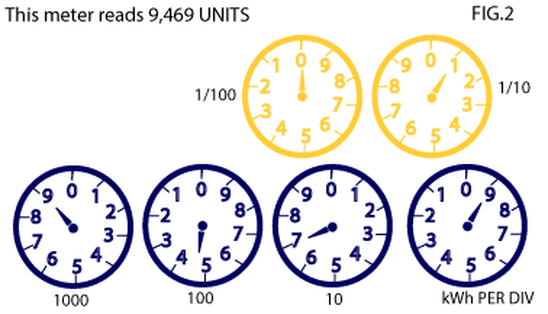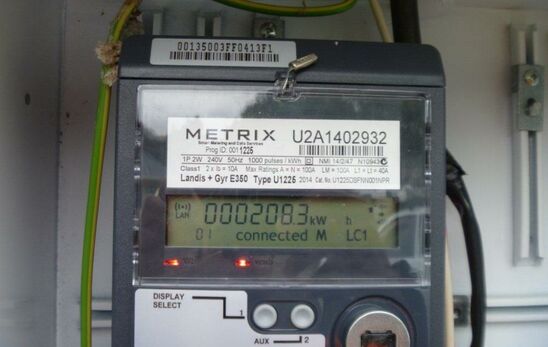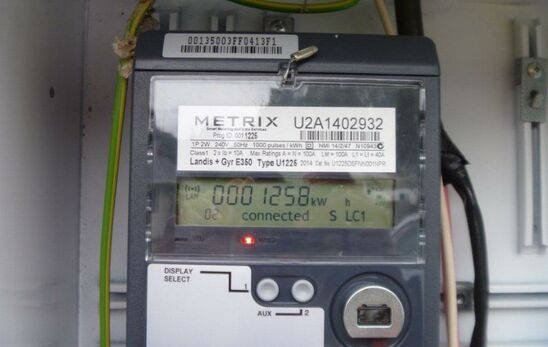Your electricity meter
Find out how electricity is measured and how to read your electricity meter.
Measuring electricity
Electricity is used by the kilowatt hour (kWh), more commonly known as a unit. One unit is equivalent to 1,000 Watts (kW) switched on for one hour.
A unit is a definite quantity, it does not vary and cannot be diluted or changed.
The wattage of an electrical appliance is the "loading" and is found marked on the small metal nameplate of the appliance.
Your electricity meter
Electricity meters are precision instruments, and extremely accurate.
As the meter records watts and hours, it has a technical name of "watt-hour-meter" and this indicates units of electricity.
There are several types of meter dials - some older types of electricity meters have indicating dials, while others use a cyclometer register.
The latest meters have liquid crystal displays similar to a calculator. Occasionally meters have two separate displays for special tariff options.
Advanced metering - Metrix and AMS Advanced (Smart) Meters
All of the electricity retailers in the Northpower network area are introducing advanced meters over time.
Your retailer's metering equipment provider owns the advanced meter. Previously, the older style meters were owned by Northpower.
Below you can find some helpful frequently asked questions about smart meters.
Frequently asked questions about smart meters
-
What are the advantages of smart meters?
Advanced meters can be read remotely so there's no need for a meter reader to come on to your property, which is handy if your meter is indoors or you have animals. They also enable remote disconnection and connection.
The final reading - which is required when leaving a property or changing retailers - can occur almost immediately.
Every electricity bill is based on 'actual' readings - no more estimates!
Smart meters allow electricity retailers to offer 'time-of-use' pricing options, meaning the cost per kWh will vary at different times of the day (often called peak, shoulder, or off-peak rates). Most retailers also have technology which allows you to analyse your electricity usage per hour, day or month.
They can measure electricity both ways, so can record electricity being generated by a solar panel or wind turbine that's being exported back to the grid.
-
Are there any concerns about radio frequency fields used in smart meters?
Information is only transmitted from smart meters once a day, for less than a minute.
Radio transmissions from smart meters is regulated and must comply with legal requirements.
If you have concerns, general information about exposure standards and health effects is available from National Radiation Laboratory of Environmental Science and Research Ltd - esr.cri.nz, or contact your electricity retailer.
-
When new meters are installed, do they have a zero reading?
Generally yes, but your retailer will have a note of your opening reading if it wasn't zero.
-
Can I still switch between electricity retailers when I've got one of their advanced meters?
Yes you can because the meter is owned by the metering equipment provider. They will also be switched to your new retailer from the date you decide to change.
-
Can I refuse to have an advanced meter installed?
Yes you can refuse to have an advanced meter but your retailer may charge you extra for having one of their meter readers manually come and read your meter.
How to read your advanced meter
The meter continuously scrolls through a number of screens.
The screens available will depend on how many phases your home has and whether you have separately metered hot water.
Read all the numbers including zeros, and note the register name for example 01-00208.3 kWh (as seen in the gallery below.) One of the readings is a total of the separately displayed meter registers.
How to read your older style electricity meter
If you'd like to keep a daily or weekly record of your electricity use, here's how to read your meter:

Ignore the small dials marked 1/10 or 1/100 and read the other dials from left to right. The dial hand should always be read as indicating the figure it has just passed, and not the one to which it may be nearest.
When the hand is between two figures, write down the lowest figure.
When the hand is between zero and nine, write down nine. When the hand is on a figure (for example seven), write down six rather than seven, unless the hand on the nearest dial to the right is between figure zero and figure one.
Go through the same process with the other dials, writing down the figures in the order left to right.
In figure 2, the reading of the meter is 9,469 units. Subtract your previous reading from the present reading and the difference will be the number of units used in the time between those readings.
Why has my electricity bill increased?
Increases or decreases in your power bill are rarely due to inaccurate or faulty meters. Visit our high power usage checklist to help work out why your power usage has changed.
Common household appliances and their use per one unit of electricity
| Appliance | Wattage | Time to use one unit of electricity |
|---|---|---|
| Single electric blanket | 70 watts | 14 hours |
| Clock | 2 watts | 500 hours |
| Food processor | 600 watts | 1.5 hours |
| One bar heater | 1000 watts | 1 hour |
| Jug | 2000 watts | 30 minutes |
| Lightbulb | 100 watts | 10 hours |
| LED lightbulb | 9 watts | 111 hours |
| Mixer | 340 watts | 3 hours |
| Large range hob | 2000 watts | 30 minutes |
| Refrigerator - thermostat controlled | 200 watts | 5 hours |
| Stereo | 100 watts | 10 hours |
| Television | 150 watts | 6.5 hours |
| Toaster | 1000 watts | 1 hour |
A checklist to help find out where your high power consumption may be from.
More info
